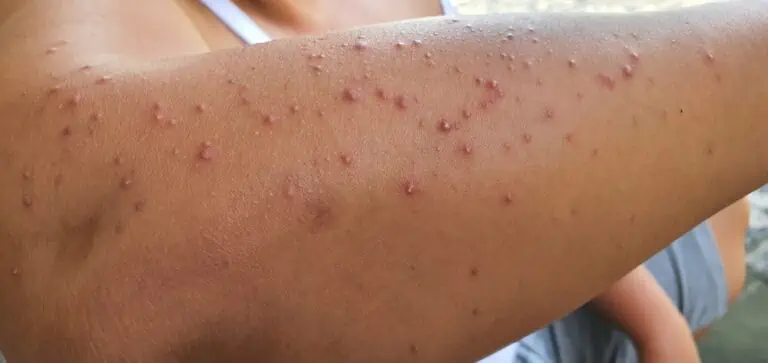Pimples on Your Arms? How to Get Rid of Arm Acne

Acne is an equal opportunity annoyance: Wherever you have oil glands, you can get breakouts. Pimples on your arms, however, might be some other skin condition masquerading as acne. If you want to know how to get rid of arm acne, first make certain that’s what you’re dealing with. Your dermatologist can tell you for sure.
Arm “pimples”: What else could they be?
Sometimes, arm acne really is acne. But often, what looks like acne on arms is one of these three problems instead.
Keratosis pilaris
If your arms look like the skin of a plucked chicken, you could have keratosis pilaris (KP), also called chicken skin. It happens when the hair follicles are clogged by a buildup of keratin, a protein found in skin. The hallmark is small, rough, red or white bumps that may be itchy. What looks like upper leg acne could be KP, too. KP is especially common when the skin is dry.
It’s practically impossible to get rid of these bumps entirely, but you can minimize them by using an over-the-counter, acid-based exfoliating product followed by a rich moisturizer.
Folliculitis
Folliculitis—literally, swelling of the hair follicles—causes acne-like bumps that may have a red ring around them. The bumps may itch and contain pus. Sometimes the cause is unknown, but folliculitis usually happens when bacteria enter the follicles. You’re more susceptible if you wear tight clothes that rub against you, sweat a lot or use hot tubs that aren’t well maintained.
Applying a warm compress for 15 to 20 minutes several times a day should help. Your dermatologist might prescribe an antibiotic cream or recommend using an anti-bacterial cleanser.
Hives
Allergic to something? A sudden outbreak of itchy raised bumps on your arm may be hives. A case of hives may come and go quickly or last for months (chronic hives). Common triggers include pet dander, pollen, bug bites, latex and certain foods and medicines, so if you know you’re allergic to any of these, it’s best to steer clear of them. Hives can also be brought on by extreme stress and even some viral or bacterial infections, like strep throat.
If you break out in hives, you can relieve the itching with cold compresses, anti-itch cream and an oral antihistamine recommended or prescribed by your doctor. Seek immediate medical help if you have trouble breathing.
Why do I have acne on my arms? (True acne)
If you really do have arm acne—blackheads, whiteheads or pimples filled with pus—it’s caused by the same problems that cause acne elsewhere, namely, pores clogged by dead skin cells, dirt and oil, which block the flow of oxygen and allow bacteria to thrive. Factors that might put you at higher risk of arm acne include:
- Your genes
- Hormone fluctuations during adolescence or pregnancy
- Medications that cause can acne, including corticosteroids, lithium, isoniazid (an antibiotic) and some cancer drugs
- Chemical sunscreens, which can cause breakouts in some people
How to get rid of arm acne: An array of treatment options
Managing true arm acne comes down to fighting clogged pores and bacteria.
“There are many treatment options for body acne, ranging from body washes to prescription medications,” said Roxanna M. Menendez, DO, a board-certified dermatologist with Riverchase Dermatology. Here are some of the go-to approaches to treating arm acne.
Benzoyl peroxide body wash
“For inflammatory acne on the arms and the trunk, I usually start by recommending a 10% benzoyl peroxide body wash or foaming cleanser,” said Dr. Menendez. (If you have red, swollen, pus-filled blemishes, you probably have inflammatory acne.) “Leave it on for three to five minutes before rinsing well,” she added. This gives the benzoyl peroxide time to sink in and do its job of killing bacteria.
If the body wash over-dries or irritates your skin, switch to one with a lower percentage of benzoyl peroxide. Keep in mind that while a 10% benzoyl peroxide product is often effective for body acne, it may be too strong for your face.
Avoid exfoliating scrubs. “These can actually make acne worse,” said Dr. Menendez.
Exfoliating salicylic or glycolic acid wash
“For patients with more comedonal acne—whiteheads or blackheads—I suggest an exfoliating salicylic or glycolic acid body wash,” said Dr. Menendez. Some body washes contain both benzoyl peroxide and one or more of these chemical exfoliants.
Topical retinols or retinoids
These products, such as over-the-counter Adapalene (Differin), are vitamin A derivatives that help acne by unclogging pores. They come in different forms, including creams, lotions and gels. Stronger prescription versions are available from your dermatologist.
Topical and oral antibiotics
For stubborn cases of body acne, your dermatologist might prescribe a topical antibiotic or even an oral antibiotic to get bacteria growth under control.
Lifestyle changes
Medicines aside, a few simple steps can help keep arm acne at bay.
Wear looser sleeves. If you favor tight, long-sleeved tops, choose tops with looser sleeves and breathable fabric.
Wash yourself, and your clothes, after your sweat. Hit the shower right after a workout or other sweat-inducing activity. Wash your skin, but don’t scrub it. Then toss your clothes into the laundry pile so you don’t wear them again and re-introduce sweat and bacteria to your skin.
Wash your sheets and towels regularly. Cotton absorbs oil and retains bacteria.
Use (the right) sunscreen. Don’t think that sun exposure will clear up your arm acne. If anything, it could make it worse by drying out your skin, causing it to produce more oil to compensate. If you think your sunscreen may be contributing to your arm acne, switch to an oil-free sunscreen. Some people have better luck with mineral sunscreens, which contain zinc oxide and/or titanium dioxide and stay on top of the skin rather than sinking in.
If over-the-counter products along with these lifestyle measures don’t help your arm acne, see your dermatologist. They can determine if you have pimples on your arms or something else entirely and develop a treatment plan that’s right for you.
Make an appointment today at one of our locations near you.
Medically reviewed by Roxanna M. Menendez, DO
Written by Maura Rhodes, a writer and editor specializing in health and well-being.


